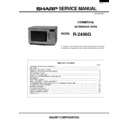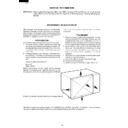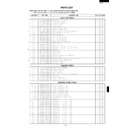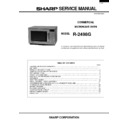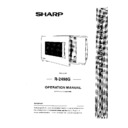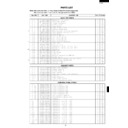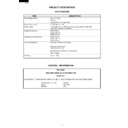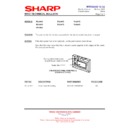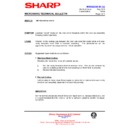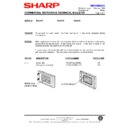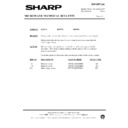Sharp R-2498G (serv.man2) Service Manual ▷ View online
23
R-2498G
CONTROL PANEL ASSEMBLY AND CONTROL UNIT REMOVAL
CONTROL PANEL ASSEMBLY REMOVAL
The complete control panel should be removed for re-
placement of components. To remove the control panel,
proceed as follows:
1. CARRY OUT 3D CHECKS.
2. Remove the air intake filter assembly from the base
placement of components. To remove the control panel,
proceed as follows:
1. CARRY OUT 3D CHECKS.
2. Remove the air intake filter assembly from the base
plate.
3. Remove two (2) screws holding the control panel to
the base plate.
4. Pull down the control panel and remove it forward.
5. Disconnect two connectors (A), (B), (D), (H) and TAB
5. Disconnect two connectors (A), (B), (D), (H) and TAB
terminal (TAB1,2,3,4) from the control unit.
6. Now the control panel assembly is free.
CAUTION FOR TOUCH CONTROL PANEL REMOVAL
1) Hold the lower end (Position A, Fig. 1) of the touch
1) Hold the lower end (Position A, Fig. 1) of the touch
control panel assembly firmly while sliding it down and
toward you.
toward you.
DO NOT FORCE THE CONTROL UNIT TO SLIDE
DOWN DURING REMOVAL. THIS MAY CAUSE DAM-
AGE TO THE CONTROL UNIT BY HITTING A RELAY
(RY-4) OR THE TAB TERMINALS LOCATED AT THE
FRONT OF THE OVEN CAVITY.
DOWN DURING REMOVAL. THIS MAY CAUSE DAM-
AGE TO THE CONTROL UNIT BY HITTING A RELAY
(RY-4) OR THE TAB TERMINALS LOCATED AT THE
FRONT OF THE OVEN CAVITY.
2) If the Touch Control Panel is hard to remove;
(1) Insert a flat head screw driver into space B . (Fig. 1)
(2) Rotate the screwdriver clockwise while holding posi-
(1) Insert a flat head screw driver into space B . (Fig. 1)
(2) Rotate the screwdriver clockwise while holding posi-
tion C of the Touch Control Panel. (Fig. 2)
TO AVOID DAMAGE TO TOUCH CONTROL PANEL,
COVER THE TIP OF SCREWDRIVER WITH TAPE.
COVER THE TIP OF SCREWDRIVER WITH TAPE.
(3) Re-solder the Relay (RY-4) prior to reinstalling the
Touch Control Panel.
B
A
C
B
Fig. 1
Fig. 2
TOUCH CONTROL PANEL
SCREW DRIVER
Replacement of individual component is as follows:
CONTROL UNIT AND CONTROL PANEL FRAME
(WITH SWITCH UNIT)
(WITH SWITCH UNIT)
7. Remove two (2) screws holding the control panel
mounting angle to the panel frame.
8. Lift up the control panel mounting angle from the panel
frame.
9. Remove six (6) screws holding the control unit to the
panel frame assembly.
10.Push down the right side two (2) hooks fixing the
control unit to the panel frame assembly, and lift up the
control unit upward.
control unit upward.
11.Now, the control unit and control panel frame (with
switch unit) are free.
CAUTION:
At installing control panel unit assembly to main
At installing control panel unit assembly to main
body set:
1. Ensure the installation of wiring-related parts with-
out negligence.
2. When inserting key cable to main body set, ensure
them free from caught-in trouble. In addition, when
installing the control panel assembly to base plate
with screws, be sure of pushing the control panel
unit upward to fix with screws firmly.
installing the control panel assembly to base plate
with screws, be sure of pushing the control panel
unit upward to fix with screws firmly.
3. Do not allow any wire leads to come near the
varistor works, because it will explode and the
wire leads near by the varistor will be damaged.
wire leads near by the varistor will be damaged.
SWITCH UNIT
12.Remove the three (3) screws holding the switch unit
(Main) to the control panel frame.
13.Remove the two (2) screws holding the switch unit
(Sub.) to the control panel frame.
14.Now, the switch unit is free
ROTARY ENCODER
12.Remove the two (2) screws holding the earth wire to
the rotary encoder and control panel mounting angle.
13.Remove the two (2) screws holding the rotary encoder
to the control panel frame.
14.Remove the knob from the rotary encoder shaft.
15.Now, the rotary encoder is free.
15.Now, the rotary encoder is free.
HOW TO RELEASE THE POSITIVE LOCK
®
CONNECTOR.
Procedure
1. Pushing the lever of positive lock
1. Pushing the lever of positive lock
®
connector.
2. Pull down the connector from the terminal.
3. Now, the connector is free.
3. Now, the connector is free.
Note: If the positive lock
®
has a insulation sleeve, first
remove it. If you do not so, you can not push the
lever of positive lock
lever of positive lock
®
.
CAUTION: The positive lock
®
terminal can not be dis-
connected by only pulling. Because once
you (Service personnel) have connected the
positive lock
you (Service personnel) have connected the
positive lock
®
connector to the terminal, the
positive lock
®
connector has been locked.
Figure C-2. How to release the positive lock connector.
Terminal
Push
Pull down
1
2
Lever
Positive lock®
connector
24
R-2498G
POWER SUPPLY CORD REPLACEMENT
1.
CARRY OUT 3D CHECKS
2.
Release the cord bushing from the rear cabinet.
3.
Disconnect the brown and blue wires of the power
supply cord from the noise filter.
supply cord from the noise filter.
4.
Loosen the single (1) screw holding the earth angle
and earth wire of power supply cord.
and earth wire of power supply cord.
5.
Remove the power supply cord.
CAUTION: DO NOT ALLOW THE WIRE LEADS OF
THE POWER SUPPLY CORD TO COME
NEAR THE HIGH VOLTAGE TRANS-
FORMER. BECAUSE THE HIGH VOLT-
AGE TRANSFORMER BECOMES HOT.
NEAR THE HIGH VOLTAGE TRANS-
FORMER. BECAUSE THE HIGH VOLT-
AGE TRANSFORMER BECOMES HOT.
Re-install
1.
1.
Insert the power supply cord into the cord bushing.
2.
Connect the brown and blue wires of power supply
cord into the terminals of noise filter, referring to
pictorial diagram.
cord into the terminals of noise filter, referring to
pictorial diagram.
3.
Insert the green/yellow wire of power supply cord
into the earth angle, and tight the screw holding the
earth angle.
into the earth angle, and tight the screw holding the
earth angle.
4.
Re-install the cord bushing to the rear cabinet.
5.
Re-install the rear cabinet to oven cavity and the
bottom plate with the eleven (11) screws and two (2)
washers.
bottom plate with the eleven (11) screws and two (2)
washers.
6.
CARRY OUT 4R CHECKS.
N
Screw
Green/Yellow
wire
wire
Cord
bushing
bushing
Rear
cabinet
cabinet
Power
supply
cord
supply
cord
Blue wire
Brown wire
Noise filter unit
L
WHT
BLK
Figure C-3. Power supply cord replacement
1ST LATCH, 2ND LATCH, 3RD LATCH, MONITOR, AND STOP SWITCHES REMOVAL
latch hook.
6. For 1st latch and stop switches removal
6-1. Disconnect the wire leads from the 1st latch and
stop switches.
6-2. Remove the single (1) screw and nut holding the
1st latch and stop switches to the latch hook.
CAUTION: WHEN THE 1ST LATCH SWITCH AND
2ND. LATCH SWITCH ARE INSTALLED,
THE TWO (2) TABS OF THE LATCH
HOOK SHOULD BE BROKEN.
THE TWO (2) TABS OF THE LATCH
HOOK SHOULD BE BROKEN.
1. CARRY OUT 3D CHECKS.
2. Remove the control panel from the oven cavity refer-
2. Remove the control panel from the oven cavity refer-
ring to “CONTROL PANEL REMOVAL”.
3. Remove the two (2) screws holding the latch hook to
the oven cavity.
4. Open the door and pull the latch hook out of the oven
cavity.
5. For 1st latch, 2nd latch or Monitor switch removal
5-1. Disconnect the wire leads from the switch.
5-2. Push the retaining tabs outward slightly and then
5-2. Push the retaining tabs outward slightly and then
pull the switch forwards and remove it from the
In case 1st latch switch, 2nd latch, stop switch, 3rd latch
switch and monitor switch do not operate properly due to a
mis-adjustment, the following adjustment should be made.
1. Loosen the two (2) screws holding the latch hook.
2. With the door closed, adjust the latch hook by moving it
switch and monitor switch do not operate properly due to a
mis-adjustment, the following adjustment should be made.
1. Loosen the two (2) screws holding the latch hook.
2. With the door closed, adjust the latch hook by moving it
back and forward, or up and down. In and out play of the
door allowed by the latch hook should be less than
0.5mm. The vertical position of the latch hook should be
placed where the stop switch and 1st, 2nd, 3rd latch
switches have activated with the door closed.
The horizontal position of the latch hook should be
placed where the monitor switch has activated with the
door closed.
door allowed by the latch hook should be less than
0.5mm. The vertical position of the latch hook should be
placed where the stop switch and 1st, 2nd, 3rd latch
switches have activated with the door closed.
The horizontal position of the latch hook should be
placed where the monitor switch has activated with the
door closed.
3. Secure the screws with washers firmly.
4. Make sure of the 1st, 2nd, 3rd latch switches, stop
4. Make sure of the 1st, 2nd, 3rd latch switches, stop
switch, and monitor switch operation. If those switches
have not activated with the door closed, loose two (2)
screws holding latch hook and adjust the latch hook
position.
have not activated with the door closed, loose two (2)
screws holding latch hook and adjust the latch hook
position.
After adjustment, make sure of the following:
1. The stop switch and 1st, 2nd, 3rd latch switches interrupt
1. The stop switch and 1st, 2nd, 3rd latch switches interrupt
the circuit before the door open when the door release
lever is pulled, and then and monitor switch close the
lever is pulled, and then and monitor switch close the
circuit when the door is opened.
2. Re-install outer case and check for microwave leakage
around the door with an approved microwave survey
meter. (Refer to Microwave Measurement Procedure.)
Figure C-4 Latch Switch Adjustments
Latch head
Monitor switch
Latch hook
1st. latch switch
2nd. latch switch
Stop switch
3rd. latch switch
Latch head
Joint lever
Door release
lever
lever
Latch lever
1ST, 2ND, 3RD LATCH SWITCH, STOP SWITCH AND MONITOR SWITCH ADJUSTMENT
25
R-2498G
DOOR REPLACEMENT
1. CARRY OUT 3D CHECKS.
2. Remove four (4) screws holding the upper and lower
2. Remove four (4) screws holding the upper and lower
oven hinge to the oven cavity.
3. Remove door assembly with upper and lower oven
hinges by pulling it forward.
4. On re-installing new door assembly, secure the upper
and lower oven hinges with the four (4) mounting
screws to the oven cavity. Make sure the door is
parallel with bottom line of the oven face plate and the
latch head pass through the latch holes correctly.
screws to the oven cavity. Make sure the door is
parallel with bottom line of the oven face plate and the
latch head pass through the latch holes correctly.
5. CARRY OUT 4R CHECKS.
Note:
Note:
After any service to the door, the approved
microwave survey meter should be used to assure
in compliance with proper microwave radiation
standards. (Refer to Microwave Measurement
Procedure.)
microwave survey meter should be used to assure
in compliance with proper microwave radiation
standards. (Refer to Microwave Measurement
Procedure.)
DOOR ADJUSTMENT
When removing and/or loosening hinges such as in door
replacement, the following adjustment criteria are taken.
Door is adjusted to meet the following three conditions by
keeping screws of hinge loose.
1. Adjust door latch heads at a position where they
replacement, the following adjustment criteria are taken.
Door is adjusted to meet the following three conditions by
keeping screws of hinge loose.
1. Adjust door latch heads at a position where they
smoothly catch the latch hook through the latch holes.
Refer to latch switch adjustments.
Refer to latch switch adjustments.
2. Deviation of the door alignment from horizontal line of
cavity face plate is to be less than 1.0mm.
3. The door is positioned with its face depressed toward
the cavity face plate.
4. Reinstall outer case and check for microwave leakage
around the door with an approved microwave survey
meter. (Refer to Microwave Measurement Proce-
dure.)
meter. (Refer to Microwave Measurement Proce-
dure.)
UPPER
OVEN
HINGE
OVEN
HINGE
LOWER
OVEN
HINGE
OVEN
HINGE
DOOR
ASSEMBLY
ASSEMBLY
LATCH HEADS
OUTER CASE
CABINET
CABINET
Figure C-5. Door Assembly Replacement and Adjustment
CHOKE COVER REMOVAL
1. Insert an iron plate (thickness of about 0.5mm or flat
type screw driver to the gap between the choke cover
and door panel as shown figure to free the engaging
part. The protect sheet may be used not to damage
the door panel.
and door panel as shown figure to free the engaging
part. The protect sheet may be used not to damage
the door panel.
2. Lift up the choke cover, now cove is free.
DOOR REPLACEMENT AND ADJUSTMENT
DOOR
PANEL
PANEL
CHOKE
COVER
COVER
FLATE TYPE
SCREW DRIVER
SCREW DRIVER
PROTECTION
BY TAPE
BY TAPE
LOWER
OVEN HING
OVEN HING
UPPER
OVEN HING
OVEN HING
Figure C-6. Choke Cover Removal
DOOR COMPONENTS REMOVAL
Remove the door assembly, referring to from item 1
through item 3 of “DOOR REPLACEMENT”.
1. Place the door assembly on a soft cloth with facing up.
through item 3 of “DOOR REPLACEMENT”.
1. Place the door assembly on a soft cloth with facing up.
(UPPER AND LOWER OVEN HINGE REMOVAL)
2. Remove the choke cover, referring to “CHOKE COVER
REMOVAL”.
3. Release the oven hinges from the door panel.
4. Now, the oven hinges are free.
4. Now, the oven hinges are free.
(DOOR HANDLE REMOVAL)
5. Remove the two (2) screws holding the door handle to
door.
6. Remove the door handle from the door panel.
(UPPER AND LOWER LATCH HEADS REMOVAL)
7. Remove the door release lever from the door assem-
7. Remove the door release lever from the door assem-
bly.
8. Remove the three (3) screws holding the joint plate to
the door panel.
9. Release the latch spring from the tab of the joint lever
and joint plate.
10.Release the latch heads from joint lever and joint plate.
11.Now, the latch heads are free.
11.Now, the latch heads are free.
(DOOR FRAME REMOVAL)
12.Set the four (4) tabs of the door frame upright.
13.Remove the door frame from the door panel. Now,
13.Remove the door frame from the door panel. Now,
door frame is free.
(DOOR GLASS REMOVAL)
14.Remove the four (4) screws holding the two (2) outside
window fixing plates to the door panel.
15.Now, the door glass is free.
25
R-2498G
DOOR REPLACEMENT
1. CARRY OUT 3D CHECKS.
2. Remove four (4) screws holding the upper and lower
2. Remove four (4) screws holding the upper and lower
oven hinge to the oven cavity.
3. Remove door assembly with upper and lower oven
hinges by pulling it forward.
4. On re-installing new door assembly, secure the upper
and lower oven hinges with the four (4) mounting
screws to the oven cavity. Make sure the door is
parallel with bottom line of the oven face plate and the
latch head pass through the latch holes correctly.
screws to the oven cavity. Make sure the door is
parallel with bottom line of the oven face plate and the
latch head pass through the latch holes correctly.
5. CARRY OUT 4R CHECKS.
Note:
Note:
After any service to the door, the approved
microwave survey meter should be used to assure
in compliance with proper microwave radiation
standards. (Refer to Microwave Measurement
Procedure.)
microwave survey meter should be used to assure
in compliance with proper microwave radiation
standards. (Refer to Microwave Measurement
Procedure.)
DOOR ADJUSTMENT
When removing and/or loosening hinges such as in door
replacement, the following adjustment criteria are taken.
Door is adjusted to meet the following three conditions by
keeping screws of hinge loose.
1. Adjust door latch heads at a position where they
replacement, the following adjustment criteria are taken.
Door is adjusted to meet the following three conditions by
keeping screws of hinge loose.
1. Adjust door latch heads at a position where they
smoothly catch the latch hook through the latch holes.
Refer to latch switch adjustments.
Refer to latch switch adjustments.
2. Deviation of the door alignment from horizontal line of
cavity face plate is to be less than 1.0mm.
3. The door is positioned with its face depressed toward
the cavity face plate.
4. Reinstall outer case and check for microwave leakage
around the door with an approved microwave survey
meter. (Refer to Microwave Measurement Proce-
dure.)
meter. (Refer to Microwave Measurement Proce-
dure.)
UPPER
OVEN
HINGE
OVEN
HINGE
LOWER
OVEN
HINGE
OVEN
HINGE
DOOR
ASSEMBLY
ASSEMBLY
LATCH HEADS
OUTER CASE
CABINET
CABINET
Figure C-5. Door Assembly Replacement and Adjustment
CHOKE COVER REMOVAL
1. Insert an iron plate (thickness of about 0.5mm or flat
type screw driver to the gap between the choke cover
and door panel as shown figure to free the engaging
part. The protect sheet may be used not to damage
the door panel.
and door panel as shown figure to free the engaging
part. The protect sheet may be used not to damage
the door panel.
2. Lift up the choke cover, now cove is free.
DOOR REPLACEMENT AND ADJUSTMENT
DOOR
PANEL
PANEL
CHOKE
COVER
COVER
FLATE TYPE
SCREW DRIVER
SCREW DRIVER
PROTECTION
BY TAPE
BY TAPE
LOWER
OVEN HING
OVEN HING
UPPER
OVEN HING
OVEN HING
Figure C-6. Choke Cover Removal
DOOR COMPONENTS REMOVAL
Remove the door assembly, referring to from item 1
through item 3 of “DOOR REPLACEMENT”.
1. Place the door assembly on a soft cloth with facing up.
through item 3 of “DOOR REPLACEMENT”.
1. Place the door assembly on a soft cloth with facing up.
(UPPER AND LOWER OVEN HINGE REMOVAL)
2. Remove the choke cover, referring to “CHOKE COVER
REMOVAL”.
3. Release the oven hinges from the door panel.
4. Now, the oven hinges are free.
4. Now, the oven hinges are free.
(DOOR HANDLE REMOVAL)
5. Remove the two (2) screws holding the door handle to
door.
6. Remove the door handle from the door panel.
(UPPER AND LOWER LATCH HEADS REMOVAL)
7. Remove the door release lever from the door assem-
7. Remove the door release lever from the door assem-
bly.
8. Remove the three (3) screws holding the joint plate to
the door panel.
9. Release the latch spring from the tab of the joint lever
and joint plate.
10.Release the latch heads from joint lever and joint plate.
11.Now, the latch heads are free.
11.Now, the latch heads are free.
(DOOR FRAME REMOVAL)
12.Set the four (4) tabs of the door frame upright.
13.Remove the door frame from the door panel. Now,
13.Remove the door frame from the door panel. Now,
door frame is free.
(DOOR GLASS REMOVAL)
14.Remove the four (4) screws holding the two (2) outside
window fixing plates to the door panel.
15.Now, the door glass is free.

